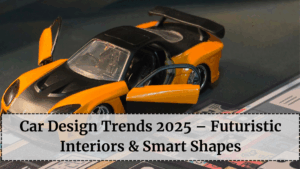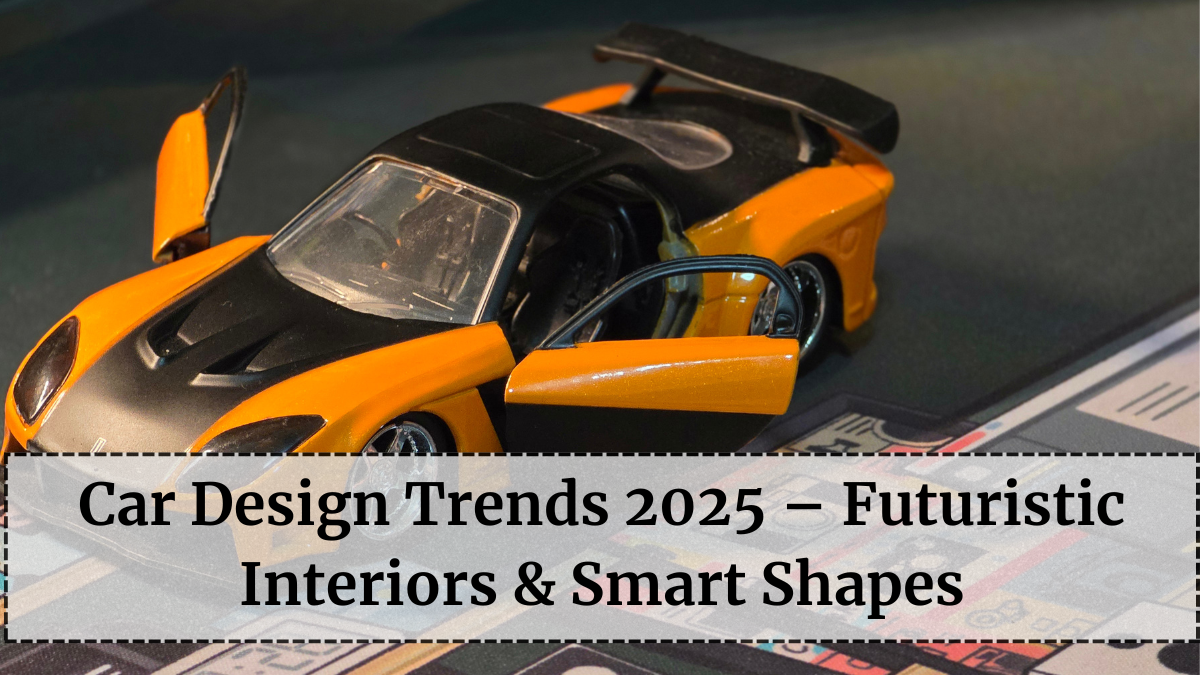The automobile world in 2025 is no longer just about engines and speed — it’s about intelligence, sustainability, and design evolution. As cars transform into smart, electric, and connected spaces, their designs are following suit.
Manufacturers worldwide are reimagining how cars look, feel, and even interact with passengers. From aerodynamic exteriors that glide through air to AI-driven interiors that respond to your emotions, the car design trends of 2025 define the future of mobility — sleek, smart, and sustainable.
Let’s explore the major design movements shaping the vehicles of 2025.

1. Aerodynamic and Minimalist Exteriors
Streamlined Shapes for Efficiency
As electric vehicles dominate the market, aerodynamics has become a central design pillar. With no need for bulky engines or large grilles, carmakers are embracing sleeker profiles and reduced drag coefficients to enhance range and speed.
Rounded edges, hidden door handles, and flush windows are replacing aggressive lines of the past. Models like Hyundai Ioniq 6, Tesla Model 3 Refresh, and BYD Seal demonstrate this clean, airflow-optimized styling.
Function Over Form
Modern designs balance aesthetics with purpose — everything from wheel rims to headlamp patterns contributes to performance. Even paint materials are evolving with solar-reflective coatings that reduce cabin heat and energy consumption.
2. Futuristic and Tech-Driven Interiors
AI at the Wheel
In 2025, the car cabin is less about driving and more about experiencing technology. AI now acts as a co-driver, adjusting lighting, seat posture, and climate based on driver mood or behavior.
Touch-free gesture controls, voice-activated dashboards, and holographic HUDs (Head-Up Displays) are becoming standard. Vehicles like the Mercedes-Benz EQS and Tata Avinya showcase how digital ecosystems and comfort can coexist seamlessly.
Minimalism with Purpose
Buttons and knobs are vanishing. Designers are opting for clean, floating dashboards with hidden vents and touch-sensitive surfaces. This “digital minimalism” enhances user experience while maximizing cabin space.
Personalized Ambient Environments
Customizable ambient lighting, aroma diffusers, and dynamic soundscapes transform cars into personalized sensory spaces. AI systems detect mood and modify interior colors or music accordingly.
3. Sustainable Materials and Eco-Design
Recycled and Plant-Based Materials
Sustainability is redefining luxury. Instead of leather and plastic, manufacturers are using:
-
Recycled PET fabrics for seats and door panels.
-
Vegan leather made from cactus or pineapple fiber.
-
Bamboo trims and cork-based dashboards for natural aesthetics.
The Volvo EX30 and BMW i Vision Circular highlight this new eco-conscious design philosophy, proving that sustainability can be elegant.
Circular Design Thinking
2025 design teams now think beyond production — they plan for end-of-life recycling, ensuring that 95% of car materials can be reused. This shift supports India’s and the world’s push toward carbon-neutral mobility.
4. Smart Lighting and Digital Surfaces
Exterior Lighting Evolution
Lighting has become the new canvas for creativity. LED and OLED light signatures allow cars to communicate visually — signaling other drivers or displaying battery charge levels.
Dynamic headlights adapt beam intensity to weather and traffic. Some concept EVs even use light patterns to greet drivers or project messages on roads.
Interior Digital Displays
Large curved infotainment screens and transparent OLED panels now stretch across dashboards, offering a futuristic, cinema-like feel. In premium EVs, rear passenger displays turn travel into an entertainment experience.
5. Compact EV Design and Urban Utility
Smaller, Smarter, and Stylish
With urban mobility on the rise, compact EVs are gaining global attention. Brands like MG Comet, Citroën eC3, and Wuling Air EV showcase how minimal footprint cars can still be high-tech and fashionable.
Designers are integrating modular seats, foldable dashboards, and space-saving layouts to enhance comfort in smaller spaces — ideal for dense Indian cities.
SUV Meets Coupe
A new hybrid category called “Coupe SUVs” is trending. These vehicles combine the practicality of SUVs with the sporty stance of coupes — examples include Tata Curvv, BYD Seal U, and Hyundai Bayon.
6. Emotionally Intelligent Design
Cars are no longer machines; they are becoming emotional companions. Designers are using biometric sensors and AI to make vehicles that adapt to your mood, driving style, and even health.
The idea is not just to transport people — but to understand them. Seats adjust posture for comfort, ambient lights shift based on heart rate, and dashboards change color to reduce stress during long drives.
7. Influence of Indian Design and Localization
India’s auto design scene is evolving rapidly. Local studios of Tata, Mahindra, and Maruti Suzuki are combining global aesthetics with Indian sensibilities — emphasizing durability, climate adaptability, and affordability.
Features like ventilated seats, sun-reflective paints, and intuitive infotainment in regional languages highlight this localization wave. Indian designers are also focusing on EV-ready modular platforms that can support diverse models with minimal retooling.
The Road Ahead – Design for Humans, Not Machines
By 2030, automotive design will revolve around human-centric innovation — vehicles that understand, adapt, and evolve with their users. AI will handle driving, but emotion and experience will define ownership.
The car design trends of 2025 are a glimpse of that future — where mobility blends art, intelligence, and sustainability into a seamless experience.
FAQs
What are the major car design trends in 2025?
Key trends include aerodynamic exteriors, AI-based interiors, sustainable materials, digital dashboards, and minimalistic aesthetics.
How are EVs changing car design?
Electric vehicles eliminate engine constraints, allowing sleeker front profiles, more cabin space, and improved aerodynamics.
Are luxury cars leading these trends?
Yes, brands like Mercedes, BMW, and Tesla introduced AI-driven cabins and recycled interiors, but Indian automakers are rapidly catching up.
What sustainable materials are being used in 2025 cars?
Materials like vegan leather, bamboo fiber, recycled plastics, and cork-based panels are replacing traditional leather and PVC.
Will car designs become fully autonomous-friendly?
Absolutely. By 2027, most car designs will support autonomous modules, featuring retractable steering and transformable cabin layouts.
Click here to know more.
